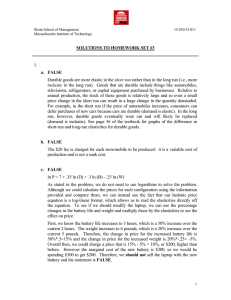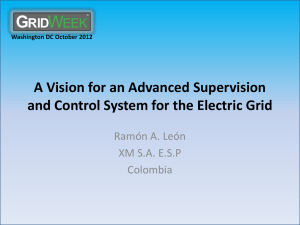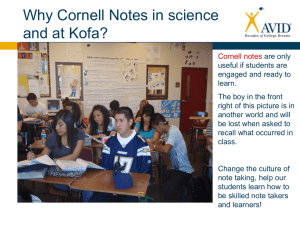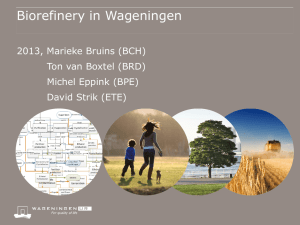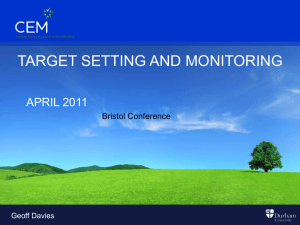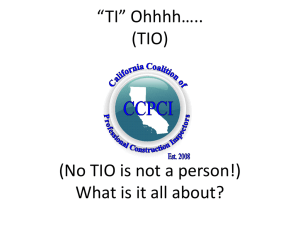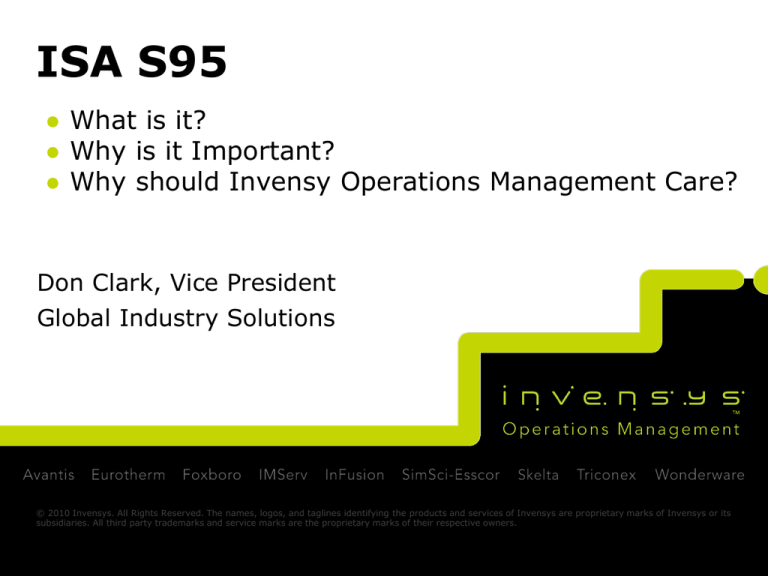
ISA S95
● What is it?
● Why is it Important?
● Why should Invensy Operations Management Care?
Don Clark, Vice President
Global Industry Solutions
© 2010 Invensys. All Rights Reserved. The names, logos, and taglines identifying the products and services of Invensys are proprietary marks of Invensys or its
subsidiaries. All third party trademarks and service marks are the proprietary marks of their respective owners.
Objectives
• ISA S95 Overview/Highlights – A “tutorial”
• Why it is important to the process
industries
– End user
– Vendor community
• How InFusion maps to S95
Topics
● The Big Picture
● Why was S95 Formed?
● Value of S95 to the Industrial Community
● Progress-to-Date
● What the Standard is, What it Covers, What it Isn’t
● Where we are Now: Current Status, Sub-committee Activity, etc.
● Application to InFusion
● Future Directions
● S95 Impacts to Operating Companies
● Call to Action!
S95: Defines Domain between DCS and ERP
S95 = “InFusion Core” Functionality
Handled well by ERP systems
Traditional CIM gap based on time domain of interest
Time domain of interest
“Invensys Operations Management” InFusion “Core”
Years
Weeks
Purdue CIM
Reference
Model
Days
Hours
Minutes
Seconds
Mili/micro seconds
Corporate/Enterprise
S95 “Sweetspot”
Gap of Unmet Needs
Plant Control/Automation Systems
Handled well by
DCS/PLC systems
Result: Disconnect between that which is planned
and that which is, can, or ought to be done.
Production Operations, or
Enterprise Control System
Months
Reference Model: Why Have a Standard?
Integration of manufacturing control systems with the rest of the
business has been one of the more difficult problems to solve
Not only technology issues, but also people and organizational problems
• Lack of common terminology (same terms often used for different things by
the two groups, or different terms used for the same things)
• Lack of consistent representation of data
• Viewpoints of what is important differ
• Critical success factors are different
At the very bottom, it casts what constitutes the information flows
between Levels 3 and Level 4 in the Purdue CIM Reference Model in a
way that is commonly available to anyone, vendor and end user
• It does not define what constitutes Levels 3 or 4 functionality, per se
• Only what constitutes activities between them
• This means those functions that are involved in inter-Level 3 and 4 messaging
must be likewise defined
Value of S95
For End-Users:
•
•
•
•
•
•
•
Provides reference to model their own business needs
Use to define what components a project needs − incrementally
Use to greatly reduce RFQ pre-work − reduces to selection list
Re-use of IP across businesses
Reduced learning curve for user and technical support: consistency
Reduces costs of inter-vendor interoperability
Used in rational vendor selection evaluation: compare against a
“gold Standard”
For Solution Providers:
•
•
•
•
•
•
•
Provides consistent solutions across industry between customers
Allows for lower cost integration services
Faster deployments
Fosters incremental solution deployments
Does allow room for innovation/differentiation within confines of Standard
Lower project bidding costs
Overall lower project costs and time
The S95 Standard: The Lay of the Land
“Enterprise Control System Integration Part 1: Models and Terminology”
• The scope of Part 1 is limited to:
2nd
a) a definition
b) a definition
c) a definition
d) a definition
rev done!
of
of
of
of
the
the
the
the
scope of the manufacturing operations and control domain;
organization of physical assets of an enterprise involved in manufacturing;
functions associated with the interface between control functions and enterprise functions; and
information that is shared between control functions and enterprise functions.
“Enterprise Control System Integration Part 2: Object Model Attributes”
• The scope of Part 2 is limited to:
–
–
the definition of attributes for the Part 1 object models.
the Part 2 standard does not define attributes to represent the object relationships defined in Part 1.
2nd rev done!
“Enterprise Control System Integration Part 3: Activity Models of Manufacturing Operations”
• The scope of Part 3 is limited to:
– A model of the activities associated with manufacturing operations and control, Level 3 functions.
– An identification of the data that flows among these activities.
Rev 2 update complete for review
“Enterprise Control System Integration Part 4: Object Models and Attributes of Manufacturing
Operations Management”
•
Note: This is a proposed Part 4, defining detailed object models of information that flows between the activities
defined in Part 3.
Out for 1st vote!
“Enterprise Control System Integration Part 5: Business to Manufacturing Transactions”
Rev 2 update complete for review
Progressive Detail & Exposure of S95 Communication Objects
● The S95 standard uses multiple models to explain the elements of Enterprise/Control System Integration.
● The initial models in the standard are very abstract, and the final models are very detailed and specific.
● Each model adds a level of detail and definition and builds on the information in the previous model.
● The standard starts with a definition of the domain of manufacturing control and the general activities
in the manufacturing domain.
● This is followed by a model of the functions within a manufacturing enterprise that relate, or interact,
with the actual manufacturing control functions.
● The functions that are directly related to the scope of the standard are given additional definition and
descriptions, and then the information that flows between these functions is defined.
S95: Hierarchy Model (Domains)
A simplified version of the complete model defined in the Purdue Reference Model for CIM
(Computer Integrated Manufacturing), combined with the MESA (Manufacturing Execution
Systems Association) model for activities in the manufacturing control domain.
Production Operations, or
Enterprise Control System
Purdue
CIM
Reference
Focus of S95 Part 1 & Part 2
Focus of S95 Part 3-5
Focuses on “the product.” The “What”
Model
Focuses on “the process.” The “How”
S95 Seeks to Formalize and “Generisize” for All Process
Markets these Workflow Activities and Functions…
Process
Manufacturing Operations
Planning
-5 year
-Annual
-Monthly
-Ad hoc
-Creates forecasts
by product:
- Unit costs
- Volumes
- Plant loads
- Labor needs
- Capital assets
Shipping/Receiving
-Logistics for shipping
-Incoming/outgoing goods
-Material dispatching
Detailed Production
Scheduling
-Done by product
-Done monthly
-Based on volume plans
and average rates
-Each process unit/line is
scheduled
-Real time schedule
optimization
Raw Materials Purchasing
-Done by product
-According to schedule
-Accommodates transport lags
-Order/deliver
-Inventory levels
-WIP storage
-Warehouse/locator system
-Stage
-Ship
Quality Assurance Operations
-Building quality in
-Defining metrics
-Define standards and procedures
-Incoming/outgoing inspections
-Make measurements/report
-Product Analysis
Production Reporting
-Cost
-Quality
-Volumes
-Rates
-Waste-by-cause
Production Engineering
-Design of Experiments
-Improve
-Production Tech-support
-Production Analysis
Production Operations
-Production Execution
-24/7 support
-Daily run time support
-Process Monitoring – Six Sigma
-Forecasts
-Actuals
-Variance
Process Engineering
-Automation
-APC
-RtOps
-Process/equipment designs
Maintenance Operations
-PM schedules
-Fix/repair/expensed
-Improve/capitalized
This is What that Looks Like in S95-speak:
Functional Enterprise Control Model: Part 1
Material and
Energy Control
(4.0)
Short Term Material
and Energy Requirements
Material and Energy
Inventory
Procurement
(5.0)
Production
Control
(3.0)
Maintenance
Management
(10.0)
Process Data
Release to ship
Product
Shipping Admin
(9.0)
Pack Out Schedule
Maintenance
Requests and Standards
Production
Scheduling
(2.0)
Product Cost
Accounting
(8.0)
Confirm to ship
Order
Processing
(1.0)
Product
Inventory Control
(7.0)
Quality
Assurance
(6.0)
Research
Development
and Engineering
Marketing
& Sales
Parts 1 and 2…
Business planning
& logistics information
Plant production scheduling,
operational management, etc
Product
definition
information
(What must be
defined to make
a product)
Production
capability
information
(What resources
are available)
Production
schedule
information
(What to
make and use)
Production
performance
information
(What was
made and used)
Manufacturing operations
& control information
Production operations, maintenance
operations, quality operations, etc
Parts 1, 2, and 3…
INFORMATION FOR MANUFACTURING OPERATIONS MANAGEMENT
Schedule/Request information
Production
schedule
Maintenance Quality Test
request
request
Performance/Response information
Inventory
request
Production Maintenance
performance response
Quality test
response
Inventory
response
Manufacturing
operations
Production
operations
management
Product
definition
information
Maintenance
operations
management
Maintenance Quality test Inventory
definition
definition
definition
information information information
Definition information
Quality
operations
management
Inventory
operations
management
Production Maintenance Quality Test
capability
capability
capability
Inventory
capability
Capability information
ISA S95 Manufacturing Architecture
ERP
PLM
CRM
SCM
Enterprise application integration
ANSI/ISA –S95 Part 1 and 2 Object model information
Product capability
(what and how much
is available to make)
Product schedule (what
to make and use)
Product response (what
was made and used)
ANSI/ISA –S95 Part 3 Activity models of Manufacturing Operations
Maintenance
Inventory
Quality
Tracking
Performance Analysis
Data collection
Execution
Resource Management
Dispatching
Scheduling
Production
Definition
Product definition
(what to make)
Process Control (Field instruments, DCS, PLC, sensors, etc.)
Manufacturing Operations
Information Models (Part 3) Example
O rd e r
P ro ce ssin g
(1 .0 )
P ro d u ctio n
S ch e d u lin g
(2 .0 )
M a te ria l a n d
E n e rg y C o n tro l
(4 .0 )
P ro cu rem e n t
(5 .0 )
P ro d u ct C o st
A cco u n tin g
(8 .0 )
P ro d u ct
S h ip p in g A dm in
(9 .0 )
P R O D U C T IO N
O P E R A T IO N S M O D E L
P ro d u ctio n
C o n tro l
(3 .0 )
M A IN T E N A N C E
O P E R A T IO N S
M ODEL
P ro d u ct
In ve n to ry C o n tro l
(7 .0 )
Q U A L IT Y
O P E R A T IO N S
M ODEL
Q u a lity
A ssu ra n ce
(6 .0 )
M a in te n a n ce
M a n a g em e n t
(1 0 .0 )
M a rke tin g
& S a le s
R e se a rch
D e ve lo p m e n t
a n d E n g in e e rin g
Progressive Detail and Exposure
Production Model from S95, Part 3
P ro d u c t
d e fin itio n
P ro d u c tio n
c a p a b ility
P ro d u c tio n
s c h e d u le
P ro d u c tio n
p e rfo rm a n c e
D e ta ile d
p ro d u c tio n
s c h e d u lin g
P ro d u c tio n
re s o u rc e
m anagem ent
P ro d u c tio n
tra c k in g
P ro d u c tio n
P e rfo rm a n c e
a n a ly s is
P ro d u c tio n
d is p a tc h in g
P ro d u c tio n
d a ta
c o lle c tio n
P ro d u c t
d e fin itio n
m anagem ent
P ro d u c tio n
e x e c u tio n
L e v e l 2 P ro c e s s C o n tro l
Maintenance Model from S95, Part 3
M a in te n a n c e
D e fin itio n s
M a in te n a n c e
R equest
M a in te n a n c e
C a p a b ility
M a in te n a n c e
R esponse
D e ta ile d
M a in te n a n c e
S c h e d u lin g
M a in te n a n c e
R e s o u rc e
M anagem ent
M a in te n a n c e
T ra c k in g
M a in te n a n c e
A n a ly s is
M a in te n a n c e
D is p a tc h in g
M a in te n a n c e
D a ta
C o lle c tio n
M a in te n a n c e
D e fin itio n
M anagem ent
M a in te n a n c e
E x e c u tio n
L e v e l 1 a n d 2 E q u ip m e n t
Quality Test Model from S95, Part 3
Q u a lity te s t
d e fin itio n s
Q u a lity te s t
c a p a b ility
Q u a lity te s t
re q u e s t
Q u a lity te s t
re s p o n s e
D e ta ile d
q u a lity te s t
s c h e d u lin g
Q u a lity
te s t re s o u rc e
m anagem ent
Q u a lity te s t
tra c k in g
Q u a lity
P e rfo rm a n c e
a n a ly s is
Q u a lity te s t
d is p a tc h in g
Q u a lity
te s t d a ta
c o lle c tio n
Q u a lity
d e fin itio n
m anagem ent
Q u a lity te s t
e x e c u tio n
L e v e l 1 a n d 2 T e s t E q u ip m e n t
Inventory Model from S95, Part 3
In v e n to ry
tra n sfe r
d e fin itio n s
In v e n to ry
tra n sfe r
c a p a b ility
In v e n to ry
tra n sfe r
re q u e st
In v e n to ry
tra n sfe r
re sp o n se
D e ta ile d
tra n sfe r
sc h e d u lin g
T ra n sfe r
re so u rc e
m anagem ent
T ra n sfe r
tra c k in g
T ra n sfe r
d isp a tc h in g
T ra n sfe r
a n a ly sis
T ra n sfe r
d a ta
c o lle c tio n
T ra n sfe r
d e fin itio n
m anagem ent
T ra n sfe r
e x e c u tio n
Level 1 and 2
T ra n s fe r e q u ip m e n t
S95: A Work-in-Progress…
It is not a compliance-rich Standard.
It is a set of guidelines and a framework:
- To align with, not comply to
● Difficulties in applying the model in any ‘literal’ way:
No extensive real life industry examples are available through white
papers, etc.
− Terminology mapping required
−
● S95 describes generic structures (name/value properties) for data
exchange but does not address how to enforce the meaning of the
contained data
A S95 ‘compliant’ message generated by Vendor A application may not
be meaningful to Vendor B’s application which supports S95 ‘compliant’
message interface
− Require extra infrastructure to support exchange of data, but simpler
than none at all.
−
Vendors and Technology Independence
The problem
• Manufacturing enterprises are typically dynamic entities. Continual changes in
business processes are necessary to meet changing business and legal environments
– The ANSI/ISA S95 series of standards aids in separating business process from
production processes. It describes information in a way that is business - and production
- process independent
– Another value of the standard to business is by separating the exchanged information
from specific implementation of manufacturing systems and specific implementations of
the business systems.
The solution
• Considering the rate of change in business and manufacturing software, a technology
independent way is needed to exchange data. XML turns out the right solution at the
right time. While multiples technologies can be used to exchange XML documents,
the documents themselves can be very stable across generations of technologies.
• XML described structured data in one document or application so that it can be used
by another application or document. By describing the components and the
relationships between them, XML can provide both structure and meaning to any type
of data. XML is platform and vendor neutral.
B2MML – XML Schemas for ISA S95
● An XML schema is an agreement between businesses on how data
should be expressed in XML
● In late 2001, a working group under the auspices of the World Batch
Forum (WBF) was formed to produce a set of XML schemas for the data
models defined in ISA-95.00.01/2
● B2MML provides a set of XML schemas based on ANSI/ISA-95
● B2MML may be used to integrate business with manufacturing systems
● Will be revised per Part 3 once formally completed to include those XML
schema as well – done
Where We Are Today…
Parts 1-4 in final stages in re-do
Have rationalized Parts 1 – Parts 5
Have formal interaction Committees on inter-Standard Alliances:
• MESA – possible marketing arm of S95 Committee
• S88WBF – batch harmonization – Tech paper completed
• MIMOSA – Maintenance Data access model
• SCOR – Supply Chain Reference Model
• S99 – Cybersecurity
• S100 – Wireless
• S106 – Procedural Automation for Continous Processes
What's Unique about the Process Industry?
1. Manufacturing is the location of a process company's "value add"
2. Manufacturing has the greatest concentration of deployed capital in assets
3. Manufacturing employs the largest number of people
Commercial
Distribution
of Personnel
Manufacturing
R&D
Administration
I/S
Supply Chain
Engineering
Manufacturing is the best place to leverage labor productivity gains!
Asset Map for Process Industries
Asset Base
Value-Add
Capital Deployed
Labor
Material/inventory
Energy
Intellectual Knowledge
Information
$
Material
Value
EBIT
Enterprise Operations Integration
ERP System
Purchasing
Inbound
Logistics
Manufacturing
Outbound
Logistics
Order
Fulfillment
Outside of R&D, manufacturing is the only segment of a chemical company's supply chain where value is added.
Manufacturing is the largest financial lever under a chemical company's control.
The Next Opportunity is Between the
Control Room and the Board Room
Enterprise Business Systems
(ERP, Customer Relationship Management)
Automate
Transactions
Manufacturing Network
Work
Definition
Management
Work
Requirements
Work
Responses
Product
Analysis (QA)
Work
Scheduling
Resource
Management
Work
Tracking
Work
Dispatching
Process
Analysis
Work
Execution
S-95 Model for MES
Plant Process
Equipment
Automate
Events
Historical
Data
Management
Personnel, Equipment, Materials
Process Control Systems
(Continuous, Batch, Discrete, SCADA)
Sensing and instrumentation
Production
Analysis
Automate
Equipment
Operational Excellence
Enterprise
Operational Excellence: InFusion
Invensys Solution Footprint in the Process Industries
Enterprise Business Systems
(ERP, Customer Relationship Management)
Automate
Transactions
Enterprise
Manufacturing Network
Work
Requirements
Work
Responses
Product
Analysis (QA)
Work
Scheduling
Resource
Management
Work
Tracking
Work
Dispatching
Process
Analysis
Work
Execution
S-95 Model for MES
Plant Process
Equipment
Automate
Events
Historical
Data
Management
Personnel, Equipment, Materials
Process Control Systems
(Continuous, Batch, Discrete, SCADA)
Sensing and instrumentation
Production
Analysis
Automate
Equipment
InFusion
Work
Definition
Management
The InFusion Vision
InFusion becomes the standard for
Enterprise Control
• Delivering integrated solutions that
will unify the production and business
environments
• It will be as pervasive to the
production environment as Microsoft
Office is for the desktop
Allowing our clients to:
• Improve business & productivity By
unifying disparate business systems
that allow our clients a common view
from which they can drive their
operation
• Outperform the competition
By improving supply chain efficiencies
across a multi site operation
Enterprise Control System
Business Applications
Manufacturing
Operations Management
Business
Operations Management
Transactional
Core
Intelligence
Engine
Industrial Data
Warehouse
Real Time
Control
Field
Devices
Controls
Advanced
Applications
Core
Real Time
Control
Access
Information
Server
Active Factory
InFusion
Historian
Engineering
Environment
Application
Environment
How We will Do It
Enterprise Control System
Business Applications
Transactional
Enterprise Control System Real-time
Operations Management “Marketecture”
Vertical
Industry
Applications
Apps
Partners
Apps
Asset
Performance
Optimization
EMI
MES
Common
Infrastructure
Application
Space
IA Apps
Historian
ERP
Integration
Config. Tools
Real-time
Operation
Management
Visualization
(HMI)
Ecosystem
Software System Platform
NonInvensys
Devices
Small
System
Controllers
(EU)
Scalable
Safety
Controllers
(IPS)
“Core”
technologies
Large
System
Controllers
(IPS)
PLCs
S95’s Impact on Operating Companies
● Provides for rigorous documentation around common standards
● Supports common workflow processes
● Faster scale ups/shorter ‘learning curves’ due to standardization
● Reduces documentation costs
● Allows for cross-industry migrations quickly
● Provides equal footing for end-user and regulatory agencies in
communications
● Promotes repetitive activities in support of standard
● Tighter linkage – repeatable, documented – between
control/execution and reporting/planning
Call to Action
● Need for more end-user participation and involvement
● Participation is free, and open to any interested party
● Every company is entitled to one vote
● Contact either:
− Keith Unger, Chair: djkunger@hotmail.com
− Don Clark, Co-Chair and US rep to ISO/IEC Committees:
don.clark@invensys.com
− Dennis Brandl, Editor: dnbrandl@brlconsulting.com
− Charley Robinson, ISA Standards Director: crobinson@ISA.org

